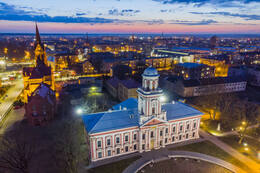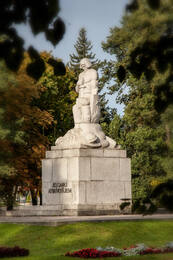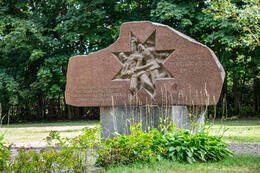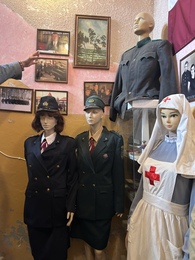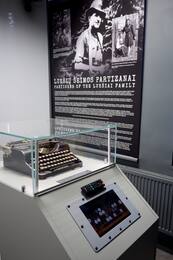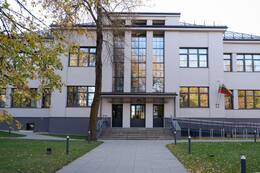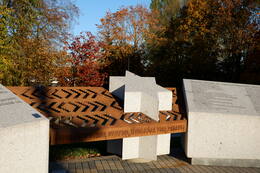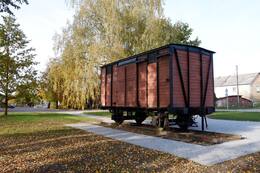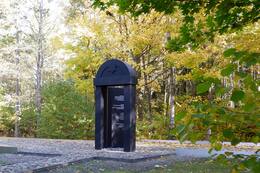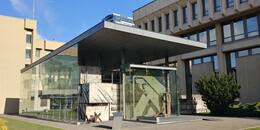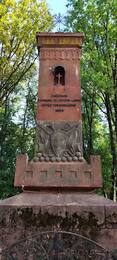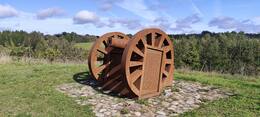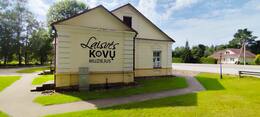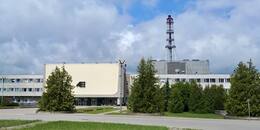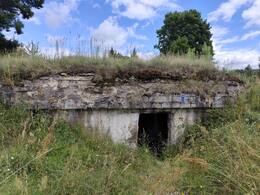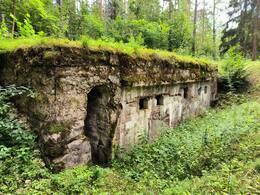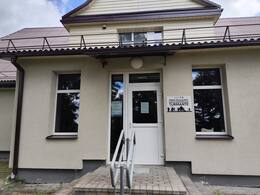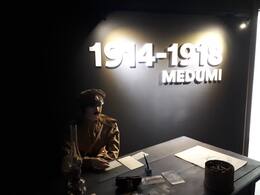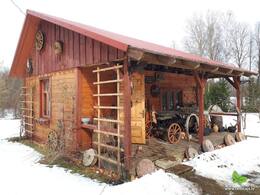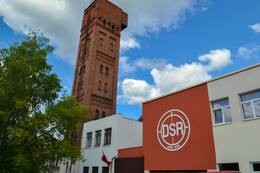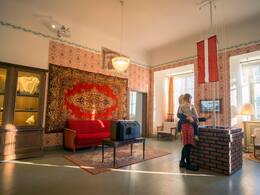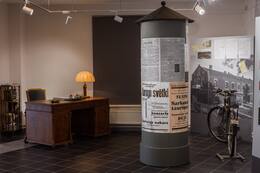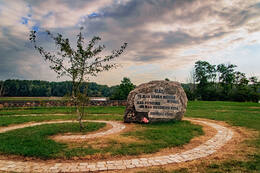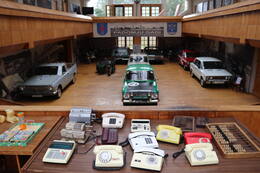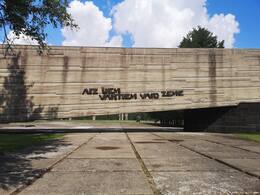Lielais pārrobežu maršruts - militārais mantojums Latvijas un Lietuvas 100 neatkarības garos
St. The tower of the Trinity Church in Jelgava, Akadēmijas Street 1, where Egon Užkurelis hoisted a homemade Latvian flag in 1952
In the tower of the St. Trinity Church in Jelgava, which was destroyed in the Soviet-German war in July-August 1944, on October 12, 1952, Egons Užkurelis, who was only 14 years old at the time, together with his friend Jānis Ģēģeris, who was a year older, hung a homemade Latvian national flag. This date was chosen because it was a Sunday when the Jelgava championship motorcycle racing took place in Pārlielupe, where many people gathered and from there the church tower could be clearly seen. The flag was made from a bed sheet, painted with watercolors. The way it was made later allowed the Chekists to guess that the flag-raisers should be sought among the students...
G. Elias Jelgava History and Art Museum
Located in the building – Academia Petrina, Jelgava.
In 1818, a private organization – the Kurzeme Literature and Art Society – established the Kurzeme Provincial Museum. At the end of 1898, it moved to a building specially designed for the museum, which was destroyed in the battles for Jelgava in the summer of 1944.
...Monument to the Liberators of Jelgava "Lāčplēsis"
Located in Jelgava, in the Station Park, opposite the Railway Station building.
The monument to the liberated people of Jelgava “Lāčplēsis” was opened on June 22, 1932, with the participation of the President of Latvia A.Kviesis, it was erected in honor of the liberation of Jelgava on November 21, 1919, during the Latvian War of Independence. In 1940, during the first period of the Soviet occupation, the monument was not affected by changes. In 1941, when the...
Monument to the Defenders of Jelgava
Located near Svēte School, Jelgava region.
In 1991, a monument to the Daugavgrīva National Guardsmen, who stopped the German army's attack on Jelgava at the end of April 1915, was unveiled near the Svēte School. In early May 1915, a large demonstration was dedicated to this event in Jelgava. The fact that the Latvian National Guardsmen managed to stop the German attack was used by J. Čakste and his associates...
Eleja War Museum.
Located in Eley, in the old railway station building.
The “Zemgales strēlnieks” association has established the Eleja War Museum in the old railway station building in Eleja. The exposition of the Eleja War Museum mainly relates to the Second World War. The museum exposition features uniforms, equipment, weapons and photographs from that time. The museum also features exhibits related to the region and Eleja, its military...
Joniškis Museum of History and Culture
Joniškis Museum of History and Culture is located in the center of Joniškis. The museum has been operating since 1989, it presents expositions representing the historical and archeological values of the region, the heritage of ethnic culture and sacred art.
On the initiative of Darius Vičas, a historian and museologist, researcher of the partisan movement, an exposition dedicated to the partisans of the Joniškis region was installed in the...
Šiauliai History Museum
Šiauliai History Museum is located in Aušras Alley, in the central part of Šiauliai city. The museum opened its doors after reconstruction in 2022. It is located in the historical building of the "Aušra" museum, built in 1932 according to the project of the local architect Vladas Bitė. At first, the building housed a school, and in 1933 part of it was given to the museum.
Today, the Šiauliai History Museum meets the latest technologies and traditional museology, a modern exposition of open storages is open, and the history of the city of Šiauliai from the first...
The Hill of Rebels
Sukilėių kalnelis is a sand hill in the western part of the city of Šiauliai, whose history was affected by both world wars.
The place became infamous in the 19th century. p. II: 1863-1864 were buried in the mound. participants of the uprising against the oppression of the Tsarist Russian Empire, sentenced to death. Horrible legends began to spread about the place, it was abandoned and rarely visited, eventually being called Rebel Hill. During World War I, soldiers of the German Empire were buried there.
in 1926 maintenance of the hill has begun. City engineer Karolis Reison volunteered to prepare a project for a monument-obelisk dedicated to the rebels. in 1928 The 10th anniversary of...
Righteous Among the Nations Square (Monument)
On October 22, 2021, the Righteous Among the Nations Square was opened in Šiauliai, at the intersection of Ežeros and Vilniaus Streets. This is the first monument to the Righteous Among the Nations in Lithuania. The author of the monument is designer Adas Toleikis, originally from Šiauliai, and the initiator is the chairman of the Šiauliai County Jewish Community, Sania Kerbelis.
The created monument “Union” features the names of the Righteous Among the Nations of the Šiauliai County, immortalizing 148 rescuers of Jews, and artistic accents mark the locations of the gates of the Šiauliai ghettos. Two ghettos were established in the city of Šiauliai: in the so-called Kaukaza quarter and in the Ežero–Trakų g. quarter. Physically strong and fit persons were sent...
Deportation train wagon
A restored deportation train carriage is located near the Radviliškis train station, reminding us of the tragic page of history when the occupying Soviet authorities massively deported the inhabitants of the Republic of Lithuania to remote areas of the Soviet Union in 1941-1952. More than 3,000 residents were deported from the city of Radviliškis alone.
In total, about 135,500 people were deported from Lithuania between 1941 and 1952. On June 14, 1941, the first day of mass deportations in Lithuania, residents of the city of Radviliškis and its surroundings began to be “placed” in the wagons of deportation trains.
...
The site of the First and Second Jewish Holocaust in Šeduva
The sites of the Šeduva I and II holocausts are located in Liaudiškių forest (Radviliškis district), about 10 km southwest of Šeduva. A point of interest is placed on the gravel road.
The first cemetery for the remains of people of the Jewish nationality occupies an area of 375 m², surrounded by a forest, most of which is paved with stones. About 400 people were killed and buried in this place. About 500 m away is the second cemetery. The remains of people of Jewish nationality are buried in an area of 144 m². The terrain of the site is flat, most of the territory is...
Sąjūdis Memorial to Lithuanian Freedom Fighters in Minaičiai (Minaičiai Bunker-Museum)
In the fall of 1948, the headquarters of the Resurrection District was looking for a place to spend the winter, and for this they chose the homestead of partisan supporters A. and S. Mikniu in the village of Minaičiai (Radviliškio district). Guerrillas dug a small bunker under the granary, where members of the district headquarters settled.
On February 16, 1949, the partisan leaders in Minaičiai concluded and announced the Lithuanian Freedom Struggle, the main goal of which was the restoration of the Lithuanian parliamentary...
Kaunas Ninth Fort Museum
Until 1890 The Russian Empire had built a system of fortifications around the perimeter of the city of Kaunas. It included 8 forts and 9 artillery batteries. The construction of IX Fort started in 1902, but was completed shortly before the First World War. During the time of the Lithuanian state, 1924 the fort became a branch of Kaunas prison. During the USSR, the NKVD prison was located here, as a transfer point to the GULAG camps. During the German occupation - the Holocaust, it was a place of execution. Today, a history museum has been established here.
...Kaunas nuclear bunker
A museum has been created in the nuclear bunker of Kaunas, which is located 6 m below the ground, which gathers exhibits of private collectors (> 1200). The most interesting are the collection of gas masks and the largest exhibition of Cold War radio equipment and spying devices in the Baltic States.
Memorial of January 13th of the Seimas of the Republic of Lithuania
In the city of Vilnius, near the Second Chamber of the Seimas of the Republic of Lithuania
in 1991 In January, due to the efforts of Lithuanian people who sought freedom and defended it, the Lithuanian Parliament House was surrounded by barricades. The barricades were an attempt to protect themselves from the military aggression of the Soviet Union at that time - Soviet attempts to carry out a coup d'état in Lithuania and restore Soviet power. It surrounded the...
Monument to the Soldiers killed for Lithuania‘s Freedom in 1920
The monument is located in the town of Giedraičiai.
On June 19, 1932, a monument to those who died for the freedom of Lithuania was unveiled in Giedraičiai. The initiators of the construction of the monument were the residents of Giedraičiai – the artist and author of the monument Antanas Jaroševičius, priest Meigys, Malvina Valeikienė and Matas Valeika, who supported the Lithuanian soldiers in battle, the Širvintos society and the...
A stylised cannon commemorating the 100th anniversary of the Battle of Giedraičiai
200 m after turning off road 172 from the town of Giedraičiai.
On November 21, 2020, a monument created by sculptor Džiugas Jurkūnas was unveiled on a hill at the site of the Battle of Giedraičiai to commemorate the victory. The monument reinterprets the interwar battles of the Lithuanian Army with the Polish Army, aiming to abandon the conflict narrative and emphasize the significance of the union of the two states in the context of...
Museum of the Battles for Freedom in Utena
In Utena, not far from the intersection of the Kaunas–Daugavpils (A6) and Vilnius–Utena (A14) highways.
The museum was established in 2015 in the former Utena narrow-gauge railway station. As it is presented, it is a museum that breathes poetry and subtly reveals the truth of the post-war period. The exhibition “Common European Identity in the Context of Totalitarian Regimes” offers to learn about the past of all of Lithuania and Europe through the history of one Lithuanian...
Ignalina Nuclear Power Plant
6 km from Visaginas, on the Visaginas–Ignalina Nuclear Power Plant road (KK177).
It is the only former nuclear power plant in the Baltic States. It is sometimes called the "sister" of the Chernobyl nuclear power plant, as both plants were built with Soviet-made RBMK-type reactors. The first reactor (power unit) of the Ignalina power plant was launched in 1983. A total of four such reactors were planned to be built. Once they were all built, the Ignalina nuclear...
Trench shelters of the German army support point in Tilžė Village
In the village of Tilžė, right next to road 5303.
In 1915–1918, the 88th Division of the German 8th Army fought against the Russian army on this front line. The shelters of the support point, which were designed to protect soldiers from powerful fire strikes, were built according to a typical scheme, differing only in the sizes of the structures. The shelter-command post was built using the strongest possible building material -...
German Army bunker (command post) of World War I
In the village of Kimbartiškės, after turning off road 5303.
In 1915–1918, the 88th division of the German 8th Army fought against the Russian army on this front line. The bunker-command post was designed to protect soldiers from powerful fire. All the bunkers were built according to a typical scheme, only the sizes of the structures differed. The bunker-command post was built using the strongest building material - concrete and...
World War I Exposition in Turmantas
In the town of Turmantas, Zarasai district.
During World War I, Turmantas was an important logistics point for the 88th Division of the German army defending the Eastern Front. The World War I exposition in Turmantas is a component of the international route “On the Trails of the First World War” and is located in the building of the Turmantas Primary School. In the modern and virtual reality-enhanced exposition, you will find...
First World War Museum in Medumi
First World War Museum is located in Medumi village, Augšdaugava municipality, in the building of former workshops of Medumi elementary school ~600 m from the A13 road.
During the First World War, the territory of present-day Augšdaugava municipality was crossed by the "Life and Death" front line, on both sides of which trenches and bunkers were built. In the forests of Medumi parish, as well as in the forests of Demene and Svente parishes, German army bunkers have been preserved, which, unlike the wooden bunkers built by the Russian army...
First World War local history collection in Medumos
It is located in the village of Medumu, Jaunatnes Street 4.
A private collection of historical evidence created by the Stikanis family. A collection of artifacts from the First and Second World War has been created, collected mostly from Medumu Parish and the surrounding area. Both military heritage items and household items, coins, photographs can be viewed.
...Museum of military vehicles in Svente manor
The collection of military equipment is located next to the Svente Manor hotel, around 20 kilometres from Daugavpils. The exhibits on display include Soviet Army tanks: a T-34 medium tank, as well as IS-2 and IS-2M heavy tanks named after Stalin, BRDM-2 and BRDM-1 armoured reconnaissance vehicles, Jeep Willys and GAZ-67 military vehicles, self-propelled machinery, cannons and other pieces of equipment. This is the largest collection of tanks in the Baltic States.
Daugavpils Shot Blasting Plant
Daugavpils Shotgun Factory was founded in 1885. The factory is the oldest ammunition manufacturing plant in Northern Europe. The only factory of its kind in the Baltics, and one of the oldest industrial heritage sites in Latvia. The factory houses the only working lead shot casting tower in Europe.
Throughout the centuries, the factory has always produced high-quality hunting shotguns, which it continues to do today. The factory displays equipment and structures that were built in the...
Daugavpils Fortress
The Daugavpils Fortress is located on the right bank of Daugava, in the western part of the city of Daugavpils. This is the only fortress of the first half of the 19th century in Northern Europe, which has survived almost unchanged. Construction began in 1810, shortly after which it suffered in the war of 1812 and the floods of 1829. The fortress was a place of strategic importance, including in the fight against Napoleon’s army. Consecrated in 1833, the fortress was completed almost half a century later, in 1878. The Daugavpils Fortress is divided into quarters, with the Parade Square located in the central part. Later the fortress lost its strategic importance and a warehouse was set up in it in 1897. Before World War I, Latvian Army officers, including General...
Jersika National Partisan Hiking Route
A hard-to-find natural object. Hike length: approximately 22 km, can be completed in approximately 6 hours.
...
Exhibition "Struggles for freedom in the 20th century" in Jēkabpils History Museum
Located in Krustpils Palace
Viewable exhibition "Fights for freedom in the 20th century"
Soviet repression. Hard memories. Sitting here in a club chair, you can listen to fragments of the book "Those were the times" by Ilmars Knaģ from Jēkabpils. On one of the walls of the room, a...
Exposition "Latvian Army in Pļaviņas in the 20th Century"
Located at Odzienas Street 2, Pļaviņas.
The permanent exposition "Latvian Army in Pļaviņas in the 20th Century" can be seen.
...A memorial dedicated to the mothers of Siberia in the "Garden of Destiny"
Located on an island in Koknese parish.
The Garden of Destiny is a symbol created in nature for the constant renewal and growth of the nation – the past, present, and future of both the person and the country meet here. Similar to the Freedom Monument, the Garden of Destiny is also created thanks to donations.
...Aizkraukle museum of History and Art, exposition "Soviet years"
The exhibit is located in the former culture house of Aizkraukle parish. It reflects the everyday social, recreational, professional, educational and cultural life in Soviet times, as well as the history of how Aizkraukle (during Soviet times – Stučka) and the Pļaviņu HPP came to be. Visitors can view the ‘Red Corner’ with its historical propaganda materials, the office of a party functionary and a typical Soviet apartment with a living room, kitchen, bathroom and toilet and their corresponding attributes. Some rooms are dedicated to Soviet medicine, tourism and sports as well as repression tactics. There is a spacious hall in the centre of the exhibit for Soviet-made vehicles. This was started in 2016 by the Aizkraukle History and Art Museum by setting up the...
Salaspils Memorial Ensemble
Salaspils Memorial and historical exhibit is located in Salaspils municipality, 1.2 km from the Riga-Daugavpils A6 highway. The Salaspils Memorial was unveiled in 1967 on the site where during World War II the Salaspils Camp was once located. It is a place that was used for Soviet propaganda and is shrouded in myths and half-truths. It is a good representation of the Nazi crimes and Communist ideology that was carried out during each of the occupations. This repressive camp was a part of the German penitentiary system. It had similarities with concentration camps, but it was not the same thing. It was created so that there would not be a disproportionate number of prisoners in Riga prisons. This camp was an “extension of the police prison”. And a variety of...





